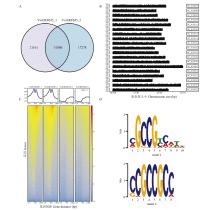













中国农业科学 ›› 2025, Vol. 58 ›› Issue (13): 2578-2590.doi: 10.3864/j.issn.0578-1752.2025.13.007
赵钰磊( ), 辛佳璐, 李承男, 李珊, 谢旭飞, 尹晓(
), 辛佳璐, 李承男, 李珊, 谢旭飞, 尹晓( )
)
收稿日期:2025-04-18
接受日期:2025-05-16
出版日期:2025-07-01
发布日期:2025-07-05
通信作者:
联系方式:
赵钰磊,E-mail:18395221615@163.com。
基金资助:
ZHAO YuLei( ), XIN JiaLu, LI ChengNan, LI Shan, XIE XuFei, YIN Xiao(
), XIN JiaLu, LI ChengNan, LI Shan, XIE XuFei, YIN Xiao( )
)
Received:2025-04-18
Accepted:2025-05-16
Published:2025-07-01
Online:2025-07-05
摘要:
【背景】 灰霉病是严重危害葡萄(Vitis vinifera)产业的重要真菌性病害。乙烯响应因子(AP2/ERF)作为植物中重要的转录因子家族,在调控植物生长发育及逆境响应过程中发挥关键作用。【目的】 探究葡萄乙烯响应因子VviERF045响应灰葡萄孢(Botrytis cinerea)侵染的分子机制,通过对其靶基因进行预测并分析其调控作用,为后续进一步解释葡萄抗灰霉病的分子机制及培育抗病新品种提供参考。【方法】 采用琼脂盘接种法和孢子悬浮液接种法对葡萄叶片进行灰葡萄孢接种,并利用实时荧光定量PCR(qRT-PCR)技术分析VviERF045及其预测靶基因的表达水平变化;通过PlantCARE在线网站预测该基因启动子区的顺式作用元件;采用MEGA 7和DNAMAN软件对VviERF045蛋白进行系统发育树构建及序列比对分析。利用农杆菌介导的葡萄‘赤霞珠’叶片瞬时转化技术,验证VviERF045在灰葡萄孢侵染过程中的功能;以欧洲葡萄‘黑比诺’叶片为试验材料,于接种灰葡萄孢12 h后,利用DAP亲和纯化测序(DAP-seq)技术在全基因组水平进行分析识别并结合的DNA元件和下游基因。【结果】 农杆菌介导的瞬时转化试验发现,在欧洲葡萄‘赤霞珠’叶片中过表达VviERF045显著增强了对灰霉病抗性;对欧洲葡萄‘黑比诺’叶片接菌12 h时进行DAP-seq分析,经两次试验组的信号峰比对发现,共51 806个重复信号峰,对这些信号峰进行promoter-TSS上下2 kb区域的基因筛选,并选取显著性前2 000的基因进行GO和KEGG功能注释。对潜在靶基因预测及信号峰分析,最终预测出3个潜在靶基因(TCP8、SAP5、bHLH48),其启动子区域均呈现显著结合峰;利用qRT-PCR进行验证,其表达水平均出现上调,表明这3个潜在靶基因可能与VviERF045共同参与对灰葡萄孢的响应过程。【结论】 VviERF045在葡萄应对灰葡萄孢侵染过程中起正调控作用,预测TCP8、SAP5、bHLH48可能共同参与灰葡萄孢调控网络。研究结果可为挖掘欧洲葡萄抗病基因提供参考。
赵钰磊, 辛佳璐, 李承男, 李珊, 谢旭飞, 尹晓. 葡萄抗灰霉病相关转录因子VviERF045下游靶基因的筛选[J]. 中国农业科学, 2025, 58(13): 2578-2590.
ZHAO YuLei, XIN JiaLu, LI ChengNan, LI Shan, XIE XuFei, YIN Xiao. Screening of Target Genes Downstream of VviERF045, a Transcription Factor Associated with Gray Mold Resistance in Vitis vinifera[J]. Scientia Agricultura Sinica, 2025, 58(13): 2578-2590.
表1
实时荧光定量PCR所用引物"
| NCBI登录号 NCBI accession number | 注释 Description | 引物序列 Primer sequence |
|---|---|---|
| XP_002272228.1 | 转录因子TCP8 Transcription factor TCP8 | F: GCTTCACTCAACCTCGTCACTCC |
| R: AGGACGCAGGCTTAGAGGATGTAG | ||
| XP_003633555.1 | A20/AN1型锌指胁迫相关蛋白5 Zinc finger A20 and AN1 domain-containing stress-associated protein 5 | F: GGTGAATCGGTGCTCTGGATGC |
| R: CGGCGGTCTTGTAATCGTAGCTG | ||
| XP_002282897.1 | 转录因子bHLH48 Transcription factor bHLH48 | F: GCGAAAGGAGCGAGAGAAGAAGG |
| R: GCTATGGCTATCAGTGGCTTGGC | ||
| XP_002276899.1 | 含LOB结构域蛋白41 LOB domain-containing protein 41 | F: TGCGGATGAGTTGTAATGGCTGTC |
| R: GCGAGGAAGACGGTGGCATTG | ||
| KX179904.1 | 乙烯转录因子ERF045,ENTAV115 Ethylene transcription factor (ERF045) | F: TCTGAAATTCGCCACCCACTTCTG |
| R: TTCTCGCCCTCGGACCACAC | ||
| VIT_12s0178g00200 | 内参 Actin | F: AACCCCAAGGCCAACAGAGAAAA |
| R: CACCATCACCAGAATCCAGCACA |

图1
VviERF045在接菌后不同时间的相对表达量 Mock:接种无菌水Inoculated with sterile water;B. cinerea:接种灰葡萄孢Inoculated with B. cinerea。数据为3个生物学重复的平均值±标准差,统计分析采用Student’s t-test The results are the mean±SD of three biological replicates, statistical analysis was performed using Student’s t-test (*0.01<P<0.05, **P<0.01)。下同The same as below"

表2
VviERF045启动子顺式作用元件分析"
| 元件名称 Element name | 序列 Sequence | 元件数量 Number of elements | 功能 Function |
|---|---|---|---|
| ATCT-motif | AATCTAATCC | 1 | 光响应元件Light-responsive element |
| Gap-box | CAAATGAA(A/G)A | 1 | 光响应元件Light-responsive element |
| GARE-motif | TCTGTTG | 1 | 赤霉素响应元件Gibberellin-responsive element |
| GATT-motif | CTCCTGATTGGA | 1 | 光响应元件Light-responsive element |
| GT1-motif | GGTTAA | 1 | 光响应元件Light-responsive element |
| I-box | TGATAATGT | 1 | 光响应元件Light-responsive element |
| TCA-element | TCAGAAGAGG | 2 | 水杨酸响应元件Salicylic acid-responsive element |
| TC-rich repeats | ATTCTCTAAC | 1 | 防御和胁迫响应元件Defence and stress-responsive element |
| TCT-motif | TCTTAC | 1 | 光响应元件Light-responsive element |

图4
VviERF045蛋白结合位点及motif分析 A:两次重复试验组信号峰韦恩图Venn diagram of peaks between two biological replicates;B:信号峰在染色体上的定位Localization of peaks on chromosomes;C:reads在转录起始位点(TSS)两侧的分布热图Heatmap of reads distribution flanking the transcription start site (TSS);D:DAP-seq分析鉴定VviERF045蛋白的DNA结合基序DAP-seq analysis identified the DNA-binding motifs of VviERF045"

表3
潜在靶基因的注释信息"
| 基因名称 Gene name | 基因编号 Gene ID | P值 P value | FDR | 蛋白名称 Uniprot_ID | 注释 Description |
|---|---|---|---|---|---|
| LOC100266605 | XP_002272228.1 | 4.42E-133 | 2.33E-128 | F6GYS5 | 转录因子TCP8 Transcription factor TCP8 |
| LOC100852428 | XP_003633555.1 | 2.01E-125 | 7.16E-121 | F6HBB0 | A20/AN1型锌指胁迫相关蛋白5 Zinc finger A20 and AN1 domain-containing stress-associated protein 5 |
| LOC100241856 | XP_002282897.1 | 7.67E-121 | 2.14E-116 | D7TI19 | 转录因子bHLH48 Transcription factor bHLH48 |
| [1] |
|
| [2] |
|
| [3] |
|
| [4] |
doi: 10.1080/07388551.2020.1768509 pmid: 32522044 |
| [5] |
doi: 10.1111/nph.12291 pmid: 24010138 |
| [6] |
|
| [7] |
|
| [8] |
|
| [9] |
|
| [10] |
|
| [11] |
|
| [12] |
|
| [13] |
|
| [14] |
|
| [15] |
|
| [16] |
|
| [17] |
王梦楠. 中国野生山葡萄转录因子VaERF20克隆与功能研究[D]. 杨凌: 西北农林科技大学, 2018.
|
|
|
|
| [18] |
柴生樾. 中国野生山葡萄抗灰霉病转录因子VaERF99功能及其作用机理[D]. 杨凌: 西北农林科技大学, 2021.
|
|
|
|
| [19] |
doi: S0092-8674(16)30481-0 pmid: 27203113 |
| [20] |
|
| [21] |
|
| [22] |
|
| [23] |
DE MICCOLIS ANGELINI R M,
|
| [24] |
doi: 10.1007/s44154-023-00140-y pmid: 38163824 |
| [25] |
|
| [26] |
doi: 10.1093/nar/gkt1249 pmid: 24335146 |
| [27] |
唐玉瑾. 葡萄VviBSs转录因子功能和机理研究[D]. 杨凌: 西北农林科技大学, 2022.
|
|
|
|
| [28] |
|
| [29] |
|
| [30] |
|
| [31] |
|
| [32] |
|
| [33] |
doi: 10.1093/plphys/kiac332 pmid: 35866682 |
| [34] |
|
| [35] |
|
| [36] |
|
| [37] |
doi: 10.1002/bies.201200181 pmid: 23640876 |
| [38] |
|
| [39] |
doi: 10.1111/j.1365-313X.2010.04459.x pmid: 21443626 |
| [40] |
doi: 10.1038/s41598-021-85754-w pmid: 33767241 |
| [41] |
|
| [1] | 张天雨, 李白, 藏金萍, 曹宏哲, 董金皋, 邢继红, 张康. 灰葡萄孢HMG家族基因的全基因组鉴定与表达规律分析[J]. 中国农业科学, 2025, 58(4): 704-718. |
| [2] | 李杰, 梁郅林, 孙燕, 檀根甲, 怀宝玉. SlSnRK1.2调控番茄抗灰霉病功能分析[J]. 中国农业科学, 2024, 57(21): 4238-4247. |
| [3] | 何军敏, 毛静艺, 魏晨, 任一帆, 张果平, 田可川, 刘桂芬. 基于miRNA测序数据解析苏博美利奴羊毛囊发育分子机制[J]. 中国农业科学, 2024, 57(19): 3917-3935. |
| [4] | 王兆昊, 郭兴茹, 张乐欢, 何永睿, 陈善春, 姚利晓. csi-miR399响应柑橘溃疡病菌侵染的表达模式及其抗病性分析[J]. 中国农业科学, 2023, 56(8): 1484-1493. |
| [5] | 许福春, 赵静若, 张振楠, 胡改元, 龙璐. 陆地棉GhCPR5的克隆及其在抗病中的功能分析[J]. 中国农业科学, 2023, 56(19): 3747-3758. |
| [6] | 邵淑君,胡璋健,师恺. 亚油酸乙醇胺诱导番茄对灰葡萄孢抗性的作用及机制[J]. 中国农业科学, 2022, 55(9): 1781-1789. |
| [7] | 郭泽西,孙大运,曲俊杰,潘凤英,刘露露,尹玲. 查尔酮合成酶基因在葡萄抗灰霉病和霜霉病中的作用[J]. 中国农业科学, 2022, 55(6): 1139-1148. |
| [8] | 宣旭娴,盛子璐,解振强,黄雨晴,巩培杰,张川,郑婷,王晨,房经贵. vvi-miR172s及其靶基因响应赤霉素调控葡萄果实发育的作用分析[J]. 中国农业科学, 2021, 54(6): 1199-1217. |
| [9] | 张伟,王世银,高莉,杨力伟,邓双义,刘晓娜,石国庆,甘尚权. 巴什拜羊不同发育阶段骨骼肌中miR-486靶基因的研究[J]. 中国农业科学, 2021, 54(14): 3134-3148. |
| [10] | 张文颖, 韩旭, 朱旭东, 解振强, 纠松涛, 黄雨晴, 贾海锋, 房经贵, 王晨. 葡萄miR159s靶基因的鉴定及其应答GA在果实不同组织的调控作用[J]. 中国农业科学, 2019, 52(16): 2858-2870. |
| [11] | 魏新燕,黄媛媛,黄亚丽,杜克久. 甲基营养型芽孢杆菌BH21对葡萄灰霉病菌的拮抗作用[J]. 中国农业科学, 2018, 51(5): 883-892. |
| [12] | 贡常委,秦旖曼,屈劲松,王学贵. 四川省草莓灰霉病菌对咯菌腈的抗性测定及其机制[J]. 中国农业科学, 2018, 51(22): 4277-4287. |
| [13] | 郭睿,杜宇,熊翠玲,郑燕珍,付中民,徐国钧,王海朋,陈华枝,耿四海,周丁丁,石彩云,赵红霞,陈大福. 意大利蜜蜂幼虫肠道发育过程中的差异表达 microRNA及其调控网络[J]. 中国农业科学, 2018, 51(21): 4197-4209. |
| [14] | 袁雪梅,王敏,藏金萍,曹宏哲,张康,张靖,邢继红,董金皋. 灰葡萄孢犬尿氨酸单加氧酶基因BcKMO与病菌cAMP信号途径的关系[J]. 中国农业科学, 2018, 51(13): 2504-2512. |
| [15] | 高翠珠,杨红玲,黄夏宇骐,黄俊斌,李国庆,郑露. 湖北省设施草莓灰霉病发生规律及流行因子分析[J]. 中国农业科学, 2017, 50(9): 1617-1623. |
|
||